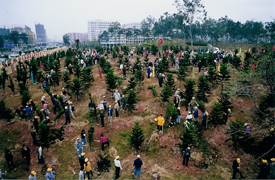
| Community Forestry [back to community agroforestry] |
| forest typology | case studies | forms | design objectives | sources |

| Case Studies | |
| mangrove reforestation | agroforestry | community forests | guangdong case study | |
Indonesia's natural forests provide complex ecosystems rich in diversity. However, natural forests continue to be destroyed for timber or have been cleared for agricultural purposes. Since the devestation of the tsunami, a majority of these ecosystems, especially lowland and coastal areas, have been destroyed. Although natural forests cannot be reclaimed, there are other alternatives in an attempt to restore this region's forest systems. Agroforestry has proved to provide economic and ecological benefit, while community forests have given locals control of their own natural resources. |
The substantial decline in mangrove forests in the Philippines within the last century. From 1920 to the late 1980s, 450,000 ha of mangrove forest to less than 150,000 ha. The 1960s to 1970s brought about the most significant decline due to an increase in the aquaculture industry. In 1984, the country's Department of Environment and Natural Resources developed the Central Regional Project which provided "secure tenure over a mangrove area to an individual or family in return for maintaining it as a healthy forest. This arrangement was called a Stewardship Agreement and was initially used to promote reforestation in open areas, as national policy at that time did not allow community management of existing mangroves." (Intercoast Network: International Newsletter of Coastal Management ). Community-based reforestation programs also provide economic benefit. When Philippino communities were directly involved in the management of these mangrove forests, costs were equivalent to $80US per hectare, while the costs of contracting individuals or organizations for labor are substantially more at approximately $400US per hectare. For more information regarding mangrove forest management, read the Intercoast Network's Special Mangrove Edition. |
| [Back to top] | |
| agroforestry |
In November of 1997, the Center for International Forestry Research (CIFOR), Cirad-Foret, and USAID sponsored an international workshop on the "management of secondary and logged-ver forests in Indonesia." The proceedings focused on the ecology of secondary growth (Rubber) agroforests. These Rubber agroforests are some of the most biodiverse forest systems, only second to natural forest systems. These secondary forests are rich in medicial plants and are high in species diversity. More importantly, agroforests are not only more ecologically sustainable than traditional agricultural practices, but are also more effective sources of livelihood, providing more local jobs and income. (source: Management of Secondary and Logged-Over Forests in Indonesia, edited by P. Sist, C. Sabogal and Y. Byron) |

| [Back to top] | |
| community forests |
"Participatory forestry refers to processes and mechanisms that enable those people who have a direct stake in forest resources to be part of decision-making in all aspects of forest management, from managing resources to formulating and implementing institutional frameworks. More specifically, community forestry refers to a component of participatory forestry that focuses on local communities as key stakeholders for sustainability." -www.fao.org |
|
The Basic Forestry Law of 1967, recognizes the rights of the community to their forests, as long as the State has no interest in its resources "only so long as the state is disinterested or unable to exploit, reserve, or lease those resources itself" (Lynch and Talbot 1995; Stockdale 1996). Since the logging boom in the 1960s and 1870s, Indonesia is notorious for the exploitation of their natural resources. The rate of deforestation was dramatically rising, and illegal forestry practices have cost the government, the ecology, and the local people. Since the late 1990s, the State has recognized that reforms must be made, including the decentralization of forestry management and respect to community's forestry rights. Community-based forestry helps strengthen communities by supporting the development of the local economy as well as safeguard precious natural resources and ecosystems that are rise of being destroyed by State-run forestry industries. Java's Social Forestry projects and the "Forest Village" Community Development Program in Pembinaan Masyarakat Desa Hutan are examples of community forestry efforts in Indonesia. According to experiences in Nepal, community forests increase natural, social, human, financial, and physical capital. For more information regarding the politics of Indonesia's Forestry Management and community-based forestry projects in and around Sumatra, read The Context for Community Forestry in Indonesia. |

| [Back to top] | |
A subtropic region at the southernmost point of China, Guangdong's hilly and mountainous topography is rich in forest resources. However, with the growing demands of development and the economy, it was critical for China to develop a forestry management plan to preserve and protect these ecosystems for economic, ecologica, and social well-being. In 2001, ten projects were proposed at the Ecological Environment Plan for Guangdong Province, six of which were to be the responsiblity of the Guangdong Forestry administration. Reforms to Guangdong's forestry industry is one component of a new program to reprioritize forestry practices, work towards developing more sustainable forest systems through protection and preservation, and the development of forestry science and technology to aid in these efforts. The goal is to carry out a series of tasks until the year 2015 that have been identified as 3, 8, 4, and 5. 3- is the development of primary, secondary, and teriary forest systems to provide a stable, ecological conscientious public forest system. 8- is the number of biological projects to be conducted in the province's 4 rivers, natural reserve, coastal protective forests, farmland, green passage,mangroves, and urban forestry. 4- represents Guangdong's 4 forest plantation industries: fast-growing/high yield, bamboo, industry materials, and cash crops. 5- are the number of forestry industries: pulp and papermaking, artificial boards, rosin, furniture, and fruit. The development of eco-tourism plans to be another profitable industry. To learn more about Guangdong Forestry link to their website. |
 |
| [Back to top] | |